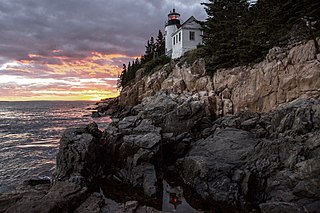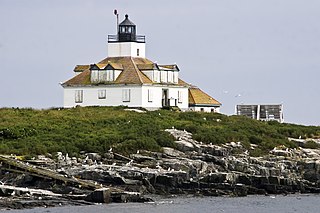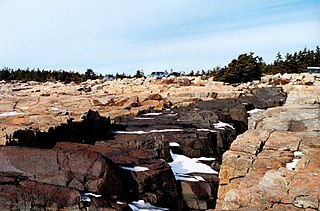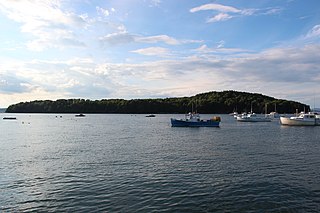
Acadia National Park is an American national park located along the mid-section of the Maine coast, southwest of Bar Harbor. The park includes about half of Mount Desert Island, part of the Isle au Haut, the tip of the Schoodic Peninsula, and portions of sixteen smaller outlying islands.

Hancock County is a county located in the U.S. state of Maine. As of the 2020 census, the population was 55,478. Its county seat is Ellsworth. The county was incorporated on June 25, 1789, and named for John Hancock, the first governor of the Commonwealth of Massachusetts.

Hancock is a town in Hancock County, Maine, United States. The population was 2,466 at the 2020 census. Located on the mainland at the head of Frenchman Bay, Hancock has commanding views of Mount Desert Island.
Sullivan is a town in Hancock County, Maine, United States. The population was 1,219 at the 2020 census. The town was named for Daniel Sullivan, an early settler. Colloquially referred to as "Sully" or "the Sullivans"—like many Maine municipalities composed of villages with geographic designations of the town proper—the municipality was incorporated in 1789. Located in the Upper Schoodic Peninsula sub-region of Maine's Downeast Acadia region, the municipality has been known as "Waukeag", "New Bristol", and later Sullivan; and once included the nearby communities of Hancock, Sorrento, and what would later be Township 7, South & Middle Districts. Once home to abundant granite quarries, the town of Sullivan is now a residential community for nearby Ellsworth and Mount Desert Island. Located along U.S. Route 1, the Taunton River, and Hog Bay, Sullivan is home to a reversing tidal falls and many scenic turnouts that dot the Schoodic National Scenic Byway along the Upper Schoodic Peninsula.

Bar Harbor is a resort town on Mount Desert Island in Hancock County, Maine, United States. As of the 2020 census, its population is 5,089. The town is home to the College of the Atlantic, Jackson Laboratory, and MDI Biological Laboratory. During the summer and fall seasons, it is a popular tourist destination.

Mount Desert Island in Hancock County, Maine, is the largest island off the coast of Maine. With an area of 108 square miles (280 km2) it is the 52nd-largest island in the United States, the sixth-largest island in the contiguous United States, and the second-largest island on the Eastern Seaboard, behind Long Island and ahead of Martha's Vineyard. According to the 2010 census, the island has a year-round population of 10,615. In 2017, an estimated 3.5 million tourists visited Acadia National Park on MDI. The island is home to numerous well-known summer colonies such as Northeast Harbor and Bar Harbor.

College of the Atlantic (COA) is a private liberal arts college in Bar Harbor on Mount Desert Island, Maine. Founded in 1969, it awards bachelors and masters (M.Phil.) degrees solely in the field of human ecology, an interdisciplinary approach to learning. Focus areas include arts and design, environmental sciences, humanities, international studies, sustainable food systems, teacher certification and educational studies, and socially responsible business. The College of the Atlantic is accredited by the New England Commission of Higher Education.

Islesford is a hamlet located on Little Cranberry Island in Hancock County, Maine, United States. It is one of the five islands of the town of Cranberry Isles. It lies in the Atlantic Ocean southeast of Mount Desert Island, which is the site of Acadia National Park. As of 2013, the year-round population was approximately sixty-five.

Bear Island is an 11-acre (4.5 ha) island located in Maine, United States. It is one of the five islands of the Town of Cranberry Isles. The island is located just off Northeast Harbor and south of Mount Desert Island.

The Schoodic Peninsula is a peninsula in Down East Maine. It is located four miles (6 km) east of Bar Harbor, Maine, as the crow flies. The Schoodic Peninsula contains 2,266 acres (9 km2), or approximately 5% of Acadia National Park. It includes the towns of Gouldsboro and Winter Harbor. The peninsula has a rocky granite shoreline containing many volcanic dikes. The peninsula is home to the former United States Navy base, NSGA Winter Harbor, which has been converted into a National Park Service training center. A 3,300-acre (13 km2) resort development was proposed for land abutting Schoodic Peninsula's national park holdings to the north. An anonymous donor eventually bought the entire 3,200-acre tract and built the Schoodic Woods Campground and miles of gravel bike paths before donating all of it to Acadia National Park. Opening in 2015, Schoodic Woods is the newest campground in Acadia National Park, and the first built in the park since the original campgrounds were built by the Civilian Conservation Corps during the Great Depression beginning in 1936. In the summer, the Schoodic peninsula is currently served by two separate ferry services from Bar Harbor to Winter Harbor that run daily.

Sutton Island, in Hancock County, Maine, United States, is a small, private island south of Mount Desert Island, and north of Cranberry Isles. Its dimensions are roughly 2.1 km on its east–west axis by 1.1 km north to south.

Bass Harbor is a village in Hancock County, Maine, United States. It is within the town of Tremont on Mount Desert Island, and near Acadia National Park. With its well-protected natural harbor, it ranks as one of the most lucrative lobster-producing ports in the state. Bass Harbor Head Lighthouse lies at the mouth of the harbor. The village is also the departure point for Maine State Ferry Service transport to Swans Island and Frenchboro.

Bar Island is a tidal island across from Bar Harbor on Mount Desert Island, Maine, United States. The uninhabited island is mostly forested in pine and birch trees and the island is now part of Acadia National Park. There are walking trails on the island. A sand and gravel bar exposed only a couple of hours at low tide connects Bar Island to Bridge Street in Bar Harbor. At low tide visitors often walk across, or park cars on the exposed bar. However, on the island side in front of a locked gate, only a small area fringed with dense sea rose bushes is elevated enough to provide safe parking. Visitors have been known to return from a hike to find their cars submerging and themselves stranded until the tide recedes.
Frenchman Bay is a bay in Hancock County, Maine, named for Samuel de Champlain, the French explorer who visited the area in 1604.
Minturn is a small village on the south side of Swan's Island, a part of Hancock County, Maine, United States. Its approximate latitude and longitude are 44°8’ N, 68°27’ W. The decline of fishing in general and of the local population has caused the village to dwindle. Its post office was consolidated with the Swans Island post office.

Baker Island Light is a lighthouse on Baker Island, Maine, which is part of Acadia National Park. The light station was established in 1828 as a guide to the southern entrance to Frenchman Bay. The present tower was built in 1855; the well-preserved tower, keeper's house, and associated outbuildings were listed on the National Register of Historic Places in 1988.
The Harbor Lane–Eden Street Historic District encompasses a neighborhood of Bar Harbor, Maine, consisting of architect-designed summer estates that served as the summer of elite society families of the late 19th and early 20th centuries. Located northwest of the main village and fronting on Frenchman Bay, the district includes nine summer houses that survived a devastating 1947 fire which destroyed many other summer estates. The district was listed on the National Register of Historic Places in 2009.
Bar Harbor is a census-designated place (CDP) in the town of Bar Harbor in Hancock County, Maine, United States. The CDP population was 2,552 at the 2010 census, out of a population of 5,235 in the town of Bar Harbor as a whole.

The Bar Harbor Inn is an inn in Bar Harbor, Maine. It was built in 1887, and has been an inn since 1950.

George Bucknam Dorr was an American preservationist. Known as the "father of Acadia National Park," he spent most of his adult life overseeing the park's formation and expansion.















